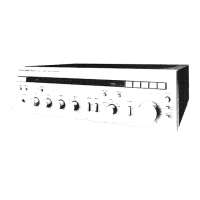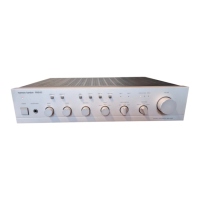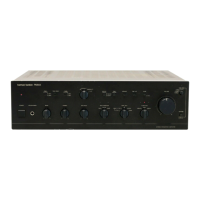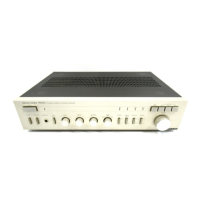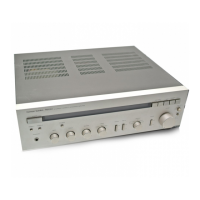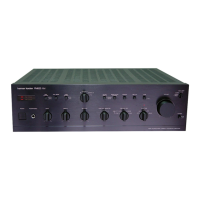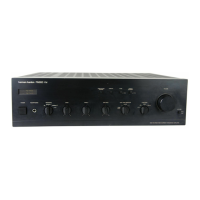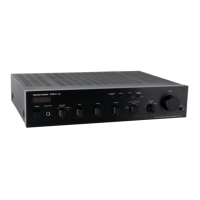Do you have a question about the Harman Kardon PM665VXI and is the answer not in the manual?
FTC power rating for both channels driven, 20-20,000Hz.
Peak current delivery capability for demanding speaker loads.
Frequency range at half rated output into 8 Ohms.
Response at 1 Watt output, +0, -3dB.
Ratio of speaker impedance to amplifier output impedance.
Ratio of rated power output to noise level (A-wtd).
Required input voltage and impedance for various inputs.
Turnover frequencies for bass and treble controls.
Specifications for subsonic and high cut filters.
Boost levels and phase shift for loudness compensation.
Physical size of the amplifier in inches and millimeters.
Physical weight of the amplifier in pounds and kilograms.
Operating voltage and frequency.
Maximum power drawn during operation.
Explains the benefit of high current for dynamic music.
Wide frequency response independent of feedback.
Design choice for low distortion and wide bandwidth.
Equalization applied in open and closed-loop paths.
Use of discrete components for high performance.
Protection system that doesn't limit performance.
High sensitivity, low noise amplifier for MC cartridges.
Feature for matching MM cartridges to phono circuitry.
Allows separation of preamplifier and power amplifier sections.
Unique feature for low-frequency equalization and phase correction.
Ensures safe operation by connecting only to domestic 120V AC outlets.
Guidelines for safely handling the power cord to prevent damage.
Recommendations for optimal placement and ventilation.
Procedure to safely disconnect the unit before moving.
Warning against opening the unit to prevent shock or damage.
Instructions for safely cleaning the unit's exterior.
Guidance on connecting various audio and video sources.
Instructions for connecting speaker wires and setting speaker modes.
Details for connecting VCRs, video players, and TVs.
How to connect a monitor television to the MONITOR OUT jack.
Explanation of switched and unswitched power outlets.
Guidance on fuse replacement and when to seek service.
Operation of the power switch and associated indicator.
Indicates when the high current mode is active.
Indicates when the high voltage mode is active.
Connection point for stereo headphones.
Adjusts the low frequency sound level.
Selects the bass turnover frequency for tone control.
Bypasses tone controls for a flat frequency response.
Adjusts the high frequency sound level.
Selects the treble turnover frequency for tone control.
Balances left and right channel sound levels.
Selects desired speaker system(s) or headphone output.
Separates preamplifier and power amplifier sections.
Activates low-frequency equalization and phase correction.
Reduces subsonic frequencies that can vibrate speakers.
Cuts off high frequency noise like scratches or hiss.
Combines left and right channels to create a mono signal.
Attenuates signal level by -20dB for temporary silence.
Selects tape deck for playback or monitoring.
Selects source for recording on tape decks or VCRs.
Selects program sources like tuner, CD, AUX, A/V.
Adjusts the overall sound level.
Matches phono input to MM or MC cartridge type.
Optimizes load capacitance for MM phono cartridges.
Step-by-step guide to playing records and adjusting tone.
How to determine and set optimum load capacitance for MM cartridges.
Guide to tuning and listening to FM/AM radio.
Instructions for playing CD sources and adjusting controls.
How to listen to auxiliary components connected to AUX jacks.
Steps for recording audio from various sources onto tape decks.
How to record radio broadcasts while listening to other sources.
Instructions for playing back recorded tapes.
Guide for dubbing tapes between two connected decks.
How to play back audio/video sources connected to A/V jacks.
Steps for recording audio/video content onto tape.
Instructions for playing back video cassettes via VCR.
Watching video sources while listening to audio sources.
Troubleshooting for power indicator issues.
Diagnosing no sound issues when the unit is powered.
Resolving issues with sound only coming from one speaker.
Troubleshooting why tone controls are unresponsive.
Correcting reversed left and right audio channels.
Diagnosing and fixing low-frequency noise from turntable.
Resolving feedback or prolonged sounds from turntable.
Addressing general issues related to sound quality.
Troubleshooting problems with recording functions.
FTC power rating for both channels driven, 20-20,000Hz.
Peak current delivery capability for demanding speaker loads.
Frequency range at half rated output into 8 Ohms.
Response at 1 Watt output, +0, -3dB.
Ratio of speaker impedance to amplifier output impedance.
Ratio of rated power output to noise level (A-wtd).
Required input voltage and impedance for various inputs.
Turnover frequencies for bass and treble controls.
Specifications for subsonic and high cut filters.
Boost levels and phase shift for loudness compensation.
Physical size of the amplifier in inches and millimeters.
Physical weight of the amplifier in pounds and kilograms.
Operating voltage and frequency.
Maximum power drawn during operation.
Explains the benefit of high current for dynamic music.
Wide frequency response independent of feedback.
Design choice for low distortion and wide bandwidth.
Equalization applied in open and closed-loop paths.
Use of discrete components for high performance.
Protection system that doesn't limit performance.
High sensitivity, low noise amplifier for MC cartridges.
Feature for matching MM cartridges to phono circuitry.
Allows separation of preamplifier and power amplifier sections.
Unique feature for low-frequency equalization and phase correction.
Ensures safe operation by connecting only to domestic 120V AC outlets.
Guidelines for safely handling the power cord to prevent damage.
Recommendations for optimal placement and ventilation.
Procedure to safely disconnect the unit before moving.
Warning against opening the unit to prevent shock or damage.
Instructions for safely cleaning the unit's exterior.
Guidance on connecting various audio and video sources.
Instructions for connecting speaker wires and setting speaker modes.
Details for connecting VCRs, video players, and TVs.
How to connect a monitor television to the MONITOR OUT jack.
Explanation of switched and unswitched power outlets.
Guidance on fuse replacement and when to seek service.
Operation of the power switch and associated indicator.
Indicates when the high current mode is active.
Indicates when the high voltage mode is active.
Connection point for stereo headphones.
Adjusts the low frequency sound level.
Selects the bass turnover frequency for tone control.
Bypasses tone controls for a flat frequency response.
Adjusts the high frequency sound level.
Selects the treble turnover frequency for tone control.
Balances left and right channel sound levels.
Selects desired speaker system(s) or headphone output.
Separates preamplifier and power amplifier sections.
Activates low-frequency equalization and phase correction.
Reduces subsonic frequencies that can vibrate speakers.
Cuts off high frequency noise like scratches or hiss.
Combines left and right channels to create a mono signal.
Attenuates signal level by -20dB for temporary silence.
Selects tape deck for playback or monitoring.
Selects source for recording on tape decks or VCRs.
Selects program sources like tuner, CD, AUX, A/V.
Adjusts the overall sound level.
Matches phono input to MM or MC cartridge type.
Optimizes load capacitance for MM phono cartridges.
Step-by-step guide to playing records and adjusting tone.
How to determine and set optimum load capacitance for MM cartridges.
Guide to tuning and listening to FM/AM radio.
Instructions for playing CD sources and adjusting controls.
How to listen to auxiliary components connected to AUX jacks.
Steps for recording audio from various sources onto tape decks.
How to record radio broadcasts while listening to other sources.
Instructions for playing back recorded tapes.
Guide for dubbing tapes between two connected decks.
How to play back audio/video sources connected to A/V jacks.
Steps for recording audio/video content onto tape.
Instructions for playing back video cassettes via VCR.
Watching video sources while listening to audio sources.
Troubleshooting for power indicator issues.
Diagnosing no sound issues when the unit is powered.
Resolving issues with sound only coming from one speaker.
Troubleshooting why tone controls are unresponsive.
Correcting reversed left and right audio channels.
Diagnosing and fixing low-frequency noise from turntable.
Resolving feedback or prolonged sounds from turntable.
Addressing general issues related to sound quality.
Troubleshooting problems with recording functions.
| Brand | Harman Kardon |
|---|---|
| Model | PM665VXI |
| Category | Amplifier |
| Language | English |

